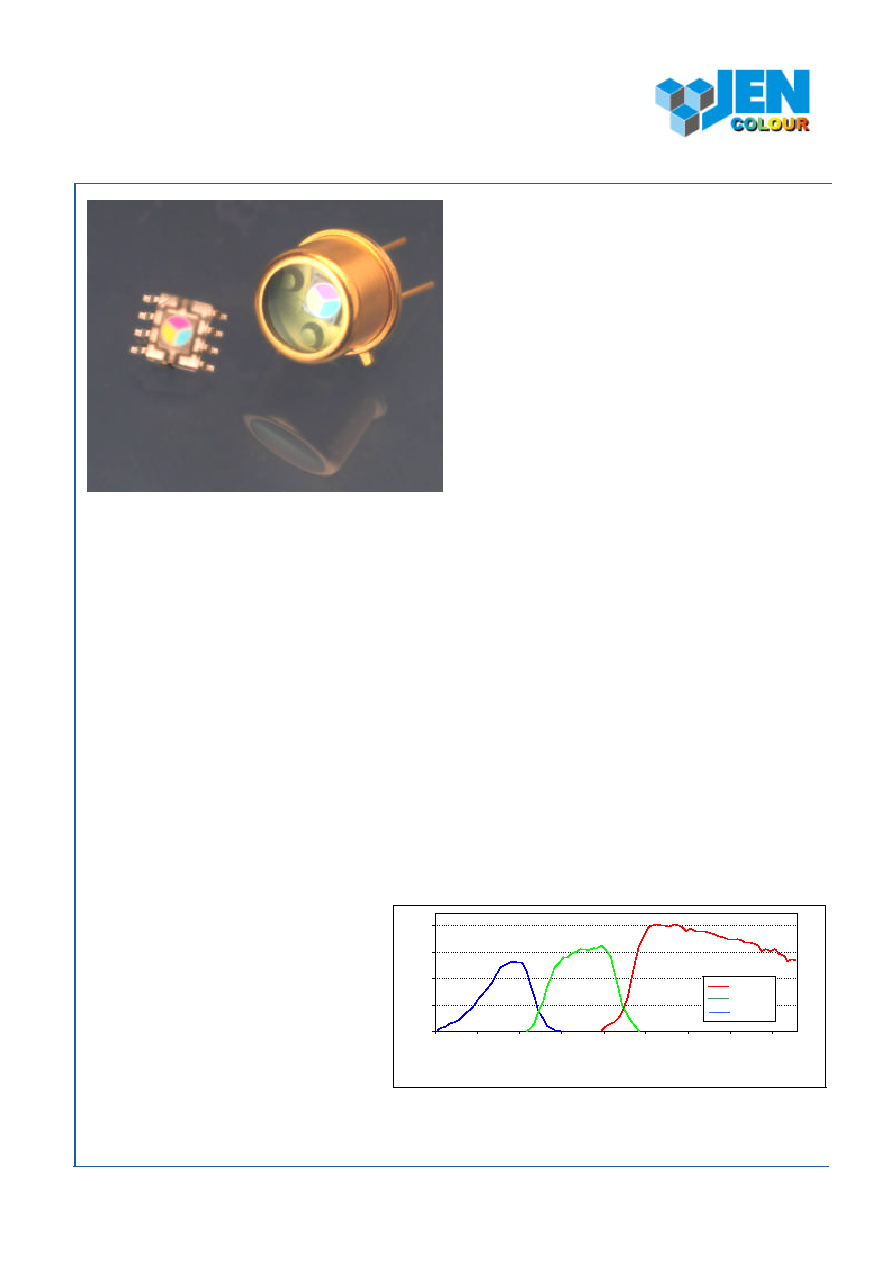
Rapid Color recognition
with compact 3-element Color sensor
MAZeT GmbH
∑
Optoelektronik
∑
Vertrieb
∑
Herr Frank Krumbein
∑
Gˆschwitzer Str. 32
∑
07745 Jena
Tel.: +49 3641 2809-17
∑
Fax: +49 3641 2809-12
∑
E-Mail: sales@mazet.de
∑
Url: http://www.MAZeT.de
i
PRODUCT INFORMATION
0,0
0,1
0,2
0,3
0,4
375
425
475
525
575
625
675
725
775
Wave length (nm)
Magnitude (A/W)
red
green
blue
The industrial Color recognition and checking
becomes easier. For low-scale applications with
high dynamics the MAZeT Color sensors are a
preferable choice. Three areas each of different
Color are responsible for the recognition - similar
to human's eye. A small design, high-quality
filters and the synchronous recording of all three-
Color ranges feature Color sensors by MAZeT.
Furthermore the circular alignment of the diodes
allows simple coupling of the measurement
signal using an optical fibre.
Î
Principal assembly
The Color sensors are made of 3 Si-PIN photo diodes integrated on chip. They are carried out as
segments of a ring with the diameter of 2,0 mm. The design as Si-PIN photo diodes allows signal
frequencies up to MHz-range. In order to achieve a small cross talk between the photodiodes the
individual sectors have been separated from each other by additional structures. Each of these
photodiodes is sensitized with dielectric spectral filter for its Color range, preferably for the primary
Colors red, green and blue.
The sensors are offered as default in the TO5 carrier with translucent plastic or cover glass, IR-
blocking or optics, and/or in the SOP8 with translucent plastic. Other packages can be delivered
custom-specifically on customer request.
Î
High-quality Color filter
Typical spectral sensitivity of the 3-
element Color sensor MCS3 sensors
use dielectric spectral filters (example
see figure). These are located directly
upon the photodiodes. Therefore the
sensor forms a compact optical
system.

Rapid Color recognition
with compact 3-element Color sensor
MAZeT GmbH
∑
Sales Optoelectronics
∑
Mr Frank Krumbein
∑
Gˆschwitzer Str. 32
∑
07745 Jena/Germany
Phone.: +49 3641 2809-17
∑
Fax: +49 3641 2809-12
∑
E-Mail: sales@mazet.de
∑
Url: http://www.MAZeT.de
ii
MAZeT GmbH 2003 PI-99-036e V1.0
PRODUCT INFORMATION
Because the filters reflect the light in the locked Color range, they have a considerably better aging resistance
than spectral filters based on the absorption principal. Furthermore, dielectric filters guarantee a high
temperature stability and environmental resistance. In this way, they are also suitable for the applications under
harsh environmental conditions. Because of their construction as a multiple layer system, different functions can
be realized with these filters. More specific, there is a possibility for special applications (e.g. limitation to a small
Color gamut) to modify the spectral characteristic curve of the spectral filters.
Î
Signal processing
At the sensors, the anodes and the common cathode are available as contacts of the individual Color ranges.
The photocurrent can be amplified and transformed by simple amplifying, comparable with a traditional
photodiode.
MTI04
MAZeT
R
U
Out
I
In
U
U
U
blue
MCS3
I
I
I
blue
green
green
red
red
VREF
The figure shows the basic building blocks of a Color detection system based on the MCS3. The measurement
object is illuminated with a white source of light. The Color sensor detects the reflected light for the three-Color
ranges red, green and blue. By using a multi-channel transimpedance amplifier the photocurrent are converted
into an equivalent voltage. The output voltage range can be adjusted to the measured photocurrent by choosing
suitable resistors (e.g. pin-programmable transimpedance amplifier MTI04 with the resistors 25k , 500k and
5M ). Then an A/D converter for further digital signal processing may digitize voltages.
Î
Advantages
Unlike other methods of measurement, three field Color sensors require only 3 measured values. These are
detected simultaneously for determining the Color. As a result, the three field sensors allow the low-cost and
fast signal processing.
By direct mounting of the spectral filters onto the photodiodes, the MCS3 is a compact sensor element. As a
result, measuring systems based on the MCS3 can be sized considerably smaller than traditional Color
measuring instruments.
Color measurement technologies often use LED-measuring systems. Different colored LED's illuminates the
object of measurement in sequence. In comparison to other sensors the Color sensor MSC3 measures all three
Colors simultaneously. It is useful for specific applications, e.g. in case of moving objects or other time-critical
measurements.
Photo
Out
x
I
V
R

